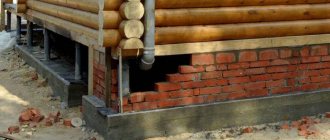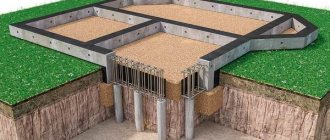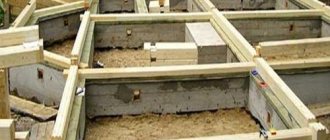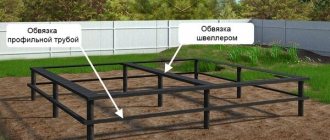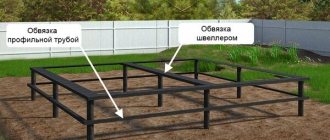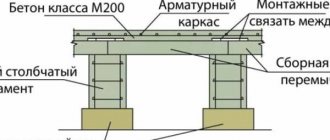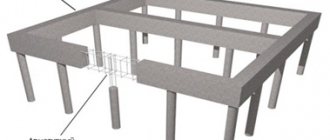The construction of any house is inextricably linked with the construction of a reliable foundation that ensures the stability of the structure. Without information about advanced technologies, some developers construct a strip foundation or build a slab version of the foundation. At the same time, on problematic soils and in conditions of sloping terrain, it is better to build a house on stilts. The screw base is constructed quickly enough, does not require increased costs and provides the necessary load-bearing capacity. Let us consider in detail the features of the technology.
Construction of houses on screw piles - general information
Screw supports are popular among developers constructing buildings on problematic soils. The decision to build a house on screw piles is made in certain situations:
- when the construction site is located on loose soils, soft soils, as well as wet soils with close groundwater;
- with significant differences in heights in the area of the construction site, as well as during the construction of a building in conditions of inclined terrain;
- if there is a lack of financial resources for the purchase of building materials intended for the construction of another type of foundation;
- if necessary, carry out the construction of a light frame structure or wooden house in a limited time;
- if there is no financial opportunity to build a drainage system in swampy soil for building a house.
The reliability and service life of the building depend on the correctly chosen type of foundation.
Screw piles for a house have a simple design and consist of the following elements:
- a steel pipe that takes the axial load from the building;
- working tip welded to the end of the pipe.
The construction of a house on screw piles is carried out according to a certain algorithm. Sequencing:
- Conduct a soil test.
- Develop project documentation.
- Decide on the design and dimensions of the elements.
- Calculate the number of supporting elements.
- Mark the location coordinates.
- Prepare materials, tools and equipment.
- Screw the columns into the ground.
- Trim the pipes to the general level.
- Weld the bearings to the pipes.
- Mount the grillage.
- Insulate the supporting structure.
- Build the building according to the project.
Let's evaluate the features of the technology.
Thanks to this technology, construction can be carried out on water and unstable soils
Foundation on screw piles: pros and cons
| Advantages of screw piles | Flaws |
|
|
Building a house on screw piles - design features
The basic element of the foundation is tubular elements with a spiral tip. The construction of houses on screw piles is carried out using supports of various designs. They differ in the shape of the working tip.
The profile could be as follows:
- standard, in the form of one full turn welded in the pipe. It is part of the foundations of light buildings;
- reinforced, consisting of two intermittent turns welded to the pipe. Able to withstand increased loads;
- narrow-blade, made in the form of a cast conical nozzle. Suitable for rocky soils;
- cylindrical in the form of a continuous spiral of constant diameter. Designed to work in permafrost conditions.
Before building a house on screw piles, you need to decide on the type of supports.
A special feature of a screw foundation is the immersion method. The piles are not driven into the soil by successive blows, but are screwed by applying a torque. As the pipe rotates, its cone-shaped tip gradually moves deeper into the soil. Reliable fastening is facilitated by compaction of the rock during the screwing process.
When choosing piles for your home, you need to consider the following points:
- grade of steel used for their manufacture;
- thickness of the coil in the working part;
- the size of the pipe wall, which determines its durability;
- quality of welds in the nozzle attachment area;
- the shape of the working blades and the total length of the support element.
The load from the mass of the structure is evenly distributed across all columns. This is achieved by leveling the tops of the pipes and securing the ends. A grillage is attached to the supports, which unites the columns into a common power circuit.
To make a grillage, choose one of the following materials:
- steel channels or I-beams;
- wooden beams;
- concrete blocks.
Such a foundation is reliable. After all, the load from the building is transferred to the grillage, which rigidly connects the columns. A quickly erected foundation allows the construction of a house to be completed in a limited time.
A pile foundation includes a group of piles interconnected by a grillage
Features of a pile-screw foundation
The pile-screw foundation is built on special pipes. The oversized threads at the ends of the elements are designed to compact the ground during the screwing process. The tops of the heel piles can be rectangular, circular or U-shaped. The choice of configuration depends on the type of structure being built.
The standard size of the supports is selected depending on the soil, load and characteristics of the object under construction. Manufacturers produce pipes with diameters from 100 to 300 mm. The wall thickness varies from 8 to 12 mm, and the length of the pipes varies from 25 cm to 2.5 meters. To increase the length, special couplings are used, which ensure the stability of the entire structure.
Pile-screw foundation. Application.
Application of foundations on screw piles
A foundation made of screw piles is not considered a reliable support for buildings for year-round use. But it is recommended for the construction of low-rise wooden frame houses in the following cases:
- construction is planned on difficult terrain;
- excavation work is impossible;
- the landscape around the site has been arranged;
- the ground freezes deeply, the soil is filled with moisture;
- foundation replacement is planned.
Foundations on screw pipes are in demand in the construction of warehouse, retail, industrial, hydraulic and advertising structures. Piles reduce vibration of buildings and are used when installing masts and to strengthen concrete foundations.
Soil requirements
Testing the soil before installation is mandatory, since the type of soil directly affects the costs, as well as the load that the pipes can withstand. Low-moving soil with groundwater located at a distance of 3 m is preferable.
Installation of a pile-screw foundation is not recommended in areas with buried hard soil. Otherwise, the supports will have to be built up more than once, which will lead to increased costs. Bulk soil significantly reduces the stability of the structure.
House on stilts - advantages of screw supports
When you decide to build a house on stilts, understand the advantages of these supports and their weak points. A house on stilts has the following advantages:
- not picky about soil. It can be built with a high concentration of clay and sand in the soil, as well as on wet soils and quicksand;
- does not depend on the influence of natural factors. Remains stable during temperature fluctuations, frost heaving of soil, shrinkage and soil erosion;
- requires small cash costs associated with the construction of the foundation. A pile field made of supporting elements is a budget solution;
- erected in a short time. After installing the pile elements, the installation of which will take no more than 2 days, construction can begin;
- can be built at any time of the year. The technology of immersion of screw supports into the ground allows work to be carried out in any weather conditions;
- low labor intensity. The design of the pile foundation allows you to build it yourself without the use of special construction equipment;
- can be erected near an existing building. This eliminates the possibility of shrinkage and negative influence of nearby buildings.
The undoubted advantages of columns also include:
- the ability to dismantle supporting elements and reuse them;
- absence of shrinkage, which allows to significantly speed up the construction cycle;
- simplicity of technology that does not require special construction preparation.
The design of this foundation makes it possible to build houses in conditions of sloping terrain, as well as in the absence of access roads for large construction equipment.
The material for making supports is used depending on the type of soil
In what cases is a concrete grillage used?
Concrete grillage is one of the most reliable methods of strapping. It has two key advantages - concrete strength and resistance to extrusion forces.
A grillage on concrete piles is suitable for the construction of houses made of brick, foam block, gas silicate and other non-plastic materials. It eliminates deflection under peak loads.
In addition to the construction of houses, pile grillage is used in other cases:
- If you need to give the base a more aesthetic appearance. Siding can be installed on a concrete base; it can be repainted or plastered.
- If necessary, insulate the space under the building or extend any communications.
- When building fences. In this case, the grillage is used both for aesthetics and for installing brick pillars.
Fluid soils and very deep peat bogs are considered contraindications for installing screw piles. It is not recommended to install piles in rocky foundations. For rocky soils, screw piles with a cast tip can be used.
Concrete foundations on screw piles are used mainly for the construction of small country houses or cottages.
Video about a concrete foundation on screw piles:
House on screw stilts - weak points of supports
Along with the advantages, the pile-screw type foundation has a number of disadvantages:
- gradual destruction of supporting columns as a result of corrosion;
- low load capacity on light types of soil;
- the difficulty of screwing elements into soil with a high stone content;
- the need for additional anti-corrosion protection of the working surface;
- inability to assess the condition of an element embedded in the soil;
- the difficulty of organizing a basement in a building on screw columns;
- the need to carry out work on geodetic soil surveys;
- the service life of the columns has been reduced to five decades;
- involvement of designers to develop a detailed design.
Disadvantages also include the increased likelihood of using columns made in artisanal conditions from low-quality materials.
Advantages and disadvantages
A pile-screw foundation is not ideal. It has both positive properties and disadvantages.
The main advantages of a foundation on screw piles:
- Ease and speed of construction. You can do it yourself within 1-2 days;
- Cleanliness during construction. This distinguishes it from monolithic foundation types;
- Low cost;
- Reliability and durability;
- A pile foundation with a monolithic grillage can be installed at any time of the year;
- Increased load-bearing capacity;
- Possibility of repeated use;
- An ideal solution for non-standard landscapes: large differences in height, limited space, etc.
How to build a house on stilts
Having assessed the positive aspects and analyzed the weak points of the foundation, you need to determine whether the selected foundation design is suitable for your building.
Building a country house on stilts has many advantages
This technology ensures the stability of lightweight buildings and structures that can be assembled independently in a limited time:
- frame buildings;
- log baths;
- utility blocks;
- various canopies;
- verandas;
- exit gate;
- wooden and mesh fences.
Let's consider the main stages of constructing a foundation for building a house:
- calculation part;
- immersion in the soil;
- grillage installation;
- insulation of the lower level.
Let us dwell on the features of each stage of work.
Calculating the number of supports
Before design begins, geodetic surveys should be carried out, which include:
- soil sampling and analysis;
- determination of the depth of aquifers.
The load capacity is then determined. For non-critical structures, you can use tabular load capacity indicators for various standard sizes of columns.
Almost all types of pile foundations are designed to withstand the load from low-rise buildings
Let's look at examples:
- a screw support, made on the basis of a pipe with a diameter of 76 mm with a working part diameter of 200 mm, can withstand 1000 kg;
- when the pipe diameter increases to 89 mm and the size of the spiral part to 250 mm, the design load accordingly increases to 2000 kg;
- an element based on a pipe with a diameter of 108 mm and a working part diameter of 300 mm has a load capacity of 250 kg.
The general calculation algorithm involves performing the following work:
- Determination of the mass of the structure. It is calculated by multiplying the volume of the walls by the density of the building material. The mass of the roof and interior elements should be added to the resulting value.
- Calculation of snow load. To calculate the indicator, it is necessary to multiply the roof area of the building by the standard value of the snow load for a particular region.
- Calculation of dynamic load. The value is determined by multiplying the base area by the base value of 350 kg per square meter of surface.
It is also necessary to take into account the wind load. It is determined from tables that take into account the maximum wind speed for a specific region. Having summed up all types of loads acting on the structure, we obtain the total total load perceived by the foundation.
The strength and durability of the house depends on the quality of the material used
. Further procedure:
- Draw a plan of the building, distributing supports in corner areas and under supporting structures.
- Divide the total load by the total number of columns and calculate the load per element.
- Select the design of the supports used, focusing on their load-bearing capacity with a safety factor of 1.2.
When performing calculations, it is necessary to round all values towards a larger value.
Design
The most common concrete screw piles consist of the following elements:
- Body (trunk) – the central part of the pile, having a circular cross-section. At the end of the upper part of the barrel there is a rectangular or square socket for a special key used when manually tightening the support.
- A helical blade is a multi-turn working part of a support located in its lower part. This part of the pile allows it to overcome dense layers of soil when twisted, provides reliable adhesion of the support to the ground, giving it a high load-bearing capacity.
- The sharp metal tip guides the support, allowing it to maintain a vertical position when screwed into the ground.
Figure 1. Design of a screw support made of concrete.
Inside the body of the support there is a cylindrical reinforcement frame and a profile pipe of square or rectangular cross-section. These elements give the pile rigidity and fracture strength.
Screwing piles for the house
Follow the specified sequence of actions when screwing:
- Mark and prepare the pits.
- Install the supports sequentially.
- Attach the screwing device.
- Screw in the supports, making sure they are vertical.
- Compact the soil around the column.
- Mark the height of the pipes and cut off the excess part.
- Fill the internal cavities with cement mixture.
After the solution has hardened, install and weld the ends to the top of the pipe.
When choosing a support, you need to study the relationship between the type of soil and the load-bearing load of the pile
We install the grillage
One of the common grillage options is a structure based on a wooden beam.
Using the example of using a beam with a cross section of 15x15 cm, we will consider the sequence of installation actions:
- Soak the wooden beam with an antiseptic.
- Place the beam on the end platforms.
- Join the beams with minimal gap.
- Secure the lower crown with self-tapping screws.
- Lay the cross beams.
- Connect them to the bottom outline.
- Waterproof the wood with mastic.
- Cover the end part of the grillage with boards.
This grillage design is double. A single option is possible, when the joining of longitudinal and transverse beams is made at the ends.
We thermally insulate the supporting part
Insulate the lower part according to the following algorithm:
- Install the sheathing frame.
- Secure the rough sheathing from boards or slabs.
- Make ventilation ducts in it.
- Attach polystyrene foam to the rough sheathing.
- Secure the decorative sheathing over the insulation.
- Install protective pads and visors.
The effectiveness of thermal insulation is influenced by properly performed waterproofing of the soil, as well as insulation and vapor barrier of the floor of the building.

